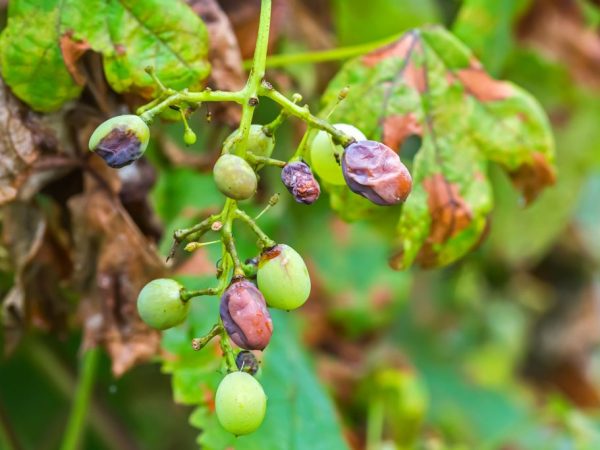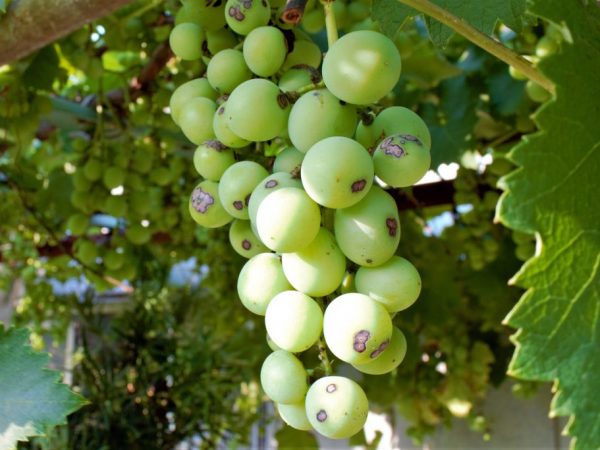Why does the grape berry turn black
The grape berry turns black from parasites, diseases and improper care. Most of the grape varieties are able to resist disease, but prevention must be carried out systematically.

Black grapes
Reasons for blackening berries
Grapes turn black quickly, so the cause should be determined promptly. Diseases are divided into:
- infectious;
- non-infectious.
Infectious diseases are those with which grapes are able to infect from other plants, affected by a fungus, virus or bacterium. This type of disease is dangerous in that not only the level of yield drops significantly, but also the entire crop dies.
In non-communicable diseases, the pathogen is absent. Reasons: improper plant care, unfavorable weather conditions, improper location of the bush.
Non-communicable diseases
Symptoms of non-communicable diseases:
- the pulp changes color;
- the ridges dry out;
- the berries are cracking;
- the color of the fruit changes;
- poor tying;
- the formation of spots both on foliage and on fruits;
- asymmetry of shoots.
The most common causes of blackheads and spots are improper watering, drying out and bending of plant ridges, and improper soil composition. Unlike infectious diseases, these are eliminated without the use of special drugs.
Bending and drying of ridges
This type of problem is most common in large varieties that have heavy bunches and the berries themselves. To avoid this situation, you need to choose the right support (for example, a gazebo or arch). Thanks to this, the grapes will fully develop, and the weight will be evenly distributed.
Drying of the ridges is another non-communicable disease. This problem occurs due to insufficient moisture. Most often this occurs during the wintering period, due to coverage and lack of oxygen.
Non-infectious chlorosis
There is another type of damage - non-infectious chlorosis, which is caused by an insufficient amount of iron in the soil, or poor absorption. A large amount of fertilizing leads to an excess of potassium in the soil, due to which it displaces other nutrients (calcium and magnesium).
Due to this disease, a large amount of hydrogen sulfide is formed in the soil. The disease progresses well in vineyards located on heavy soils, where oxygen is poorly supplied. If the plant does not feed well and breathes, then it becomes weakened, the berries are peas without ripening, and this leads to further death. If you lose sight of this disease, then the entire crop perishes. For prevention, use a solution of green soap.
Infectious diseases

Disease can destroy an entire vineyard
Even the most dangerous reasons for the appearance of black dots on grapes are infectious diseases:
- oidium;
- milde;
- anthracnose;
- escoriasis (black spot);
- bacterial cancer.
Infectious diseases are not necessarily transmitted from infected plants, they can be carried by water, people, animals. This type is the most dangerous, as it leads to the absolute death of the entire vineyard. As for non-communicable diseases, a solution of green soap is used for prophylaxis.
Milde
The causative agent of the most common mildew disease is powdery mildew. Most often, the disease is seen on European grape varieties. Habitat - fallen leaves, in which the parasite lives all winter. The spores of this fungus enter the plant through water and soil. Milde easily tolerates cold and moisture.
The rate of development of mildey depends on temperature conditions, the incubation period of the fungus:
- May - about 3 weeks;
- first half of June - 2 weeks;
- second half of June - 1 week;
- July and August - 5 days.
It is not difficult to identify mildew. Light, shiny spots form on the foliage, which quickly increase. The inner side of the leaf is covered with a white coating.
Oidium
It is difficult to determine oidium with the naked eye. The first symptom of a fungus is the appearance of a white coating on the leaves. The comfortable temperature for breeding is 5 ° -30 ° С, the climate is arid and warm.
When the oidium is damaged, the leaves become covered with a white coating, if you wipe it off, an unpleasant odor appears. It progresses only on young plants, does not affect the formed bushes.
The incubation period is 2 weeks. Occurs in unventilated areas of grapes.
Black spot
Black spots on grapes are also caused by black spotting. This dangerous ailment penetrates into plant cells through damaged areas. The fungus covers the entire bush, including the brushes and clusters.
Spores are transmitted by wind, parasites and rain. Damage to cells with black spots occurs when the air humidity is more than 85%, and the air temperature is more than 15 ° C.
Mostly young shoots and brushes are exposed to the fungus in June. The appearance of black dots is noticed on the foliage, the edges of the affected areas become harder. After the foliage, flowers and fruits are affected.
Anthracnose
Anthracnose is a fungus that spreads by sediment and thrives in humid climates. It is most active at high air temperatures - from 20-30 ° C. Anthracnose enters the plant through mechanical damage.
Symptoms of the disease:
- the tip of the leaf turns black, and the middle darkens and becomes dry;
- the appearance of spots up to 5 mm;
- darkened areas dry and fall off, forming holes;
- leaves become ugly and fall off;
- raised leaf edges.
Bacterial cancer
Gardeners distinguish this type of disease from others, as it is common for all varieties, and leads to the death of entire vineyards. The bacterium is most common in cold areas.
The cause of damage is damage to the shoot, through which the disease enters the body, as well as unfavorable weather conditions that weaken the plant. During vaccinations, there is a risk of bacterial cancer.
Bacterial cancer cannot be cured by any means. The only way out is to remove and burn, so that other shrubs do not become infected.
Conclusion
There are two types of diseases for grapes that cause blackheads and spots - infectious and non-infectious. Non-infectious can be cured without the use of special tools.
Infectious diseases are more dangerous, it is more difficult to remove them. If you notice the disease in time, treatment is possible. The most common causes of disease are improper care, unfavorable climatic conditions and mechanical damage through which pathogens enter the plant's body.

